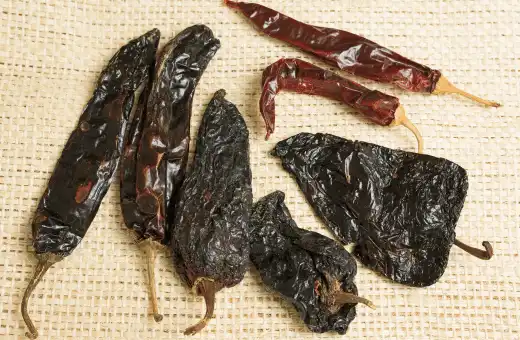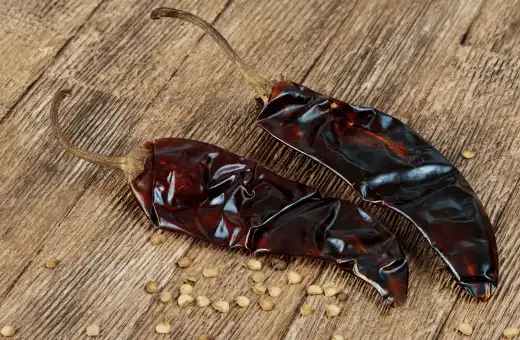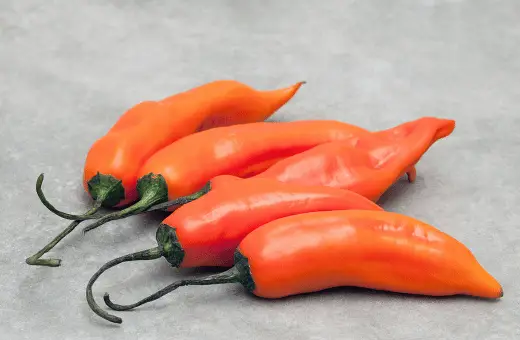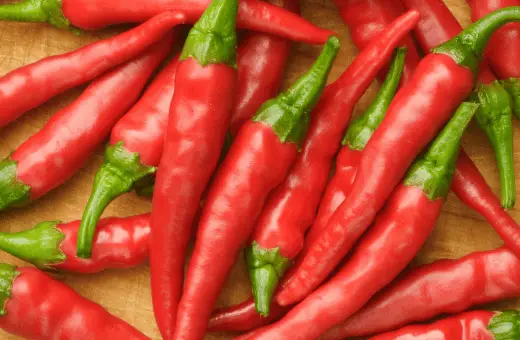Cascabel chiles are a common ingredient in many Mexican and Tex-Mex recipes. They have a nutty flavor and a mild to medium heat level.
However, they may not be readily available in every region or grocery store. Thankfully, there are several substitutes that can work in place of cascabel chiles.
In this blog post, I’ll share 15 of the best cascabel chiles substitutes and give you tips on how to use them efficiently.
In short, " What can I use instead of cascabel chiles?" Ancho Chili, Pasilla Chile, Chipotle Pepper, Guajillo Chile, New Mexico Chili, Aleppo Pepper, Puya Chile, Aji Amarillo, Thai Chili, Red Pepper Flakes, New Mexico Chiles, Cayenne Peppers and many more.
What is cascabel chiles and what does cascabel chiles taste like?
Cascabel chiles, also known as “rattle chiles,” are a type of dried chili pepper commonly used in Mexican cuisine. They are round and small, usually measuring about 1 to 2 centimeters in diameter.
Cascabel chiles are known for their deep reddish-brown color and their unique rattling sound when shaken, which gives them their name.
In terms of flavor, cascabel chiles have a moderately mild to medium heat level, ranging from 1,000 to 3,000 Scoville heat units.
Their flavor profile is often described as earthy, slightly smoky, and nutty, with hints of dried fruit and tobacco. They have a pleasant complexity that adds depth to various dishes.
Uses of cascabel chiles
Cascabel chiles are versatile and can be used in various culinary applications to add flavor, heat, and complexity to dishes. Here are some common uses:
1. Salsas and Hot Sauces: Cascabel chiles can be used to make flavorful salsas and hot sauces. They contribute a unique earthy and smoky flavor to the condiments.
2. Mexican Mole Sauces: Cascabel chiles are often included in traditional mole sauces, adding a depth of flavor and mild heat. They help balance the sweetness and richness of the sauce.
3. Stews and Soups: These chiles can be added to stews, soups, and slow-cooked dishes, infusing them with their distinctive flavor and mild spiciness.
4. Meat and Poultry Dishes: Cascabel chiles can be incorporated into marinades or rubs for meats and poultry, enhancing their flavor and providing a subtle heat.
5. Rice and Grain Dishes: Adding cascabel chiles to rice or grain dishes can impart a smoky and earthy flavor, making them more interesting and aromatic.
6. Vegetarian and Vegan Dishes: Cascabel chiles can be used to spice up vegetarian or vegan dishes, such as bean-based stews, vegetable curries, or roasted vegetables.
7. Infused Oils and Vinegars: Cascabel chiles can be used to create flavored oils or vinegar. By infusing them, you can incorporate their unique taste into dressings, marinades, or dipping sauces.
When working with cascabel chiles, it’s essential to handle them carefully, as they have seeds and can be moderately spicy. Adjust the number of chiles based on your desired heat level.
Where to buy cascabel chiles?
If you searching for where to buy cascabel chiles, there are a few different places you can go. Many specialty food stores carry it, as do some international grocery stores.
You can also order online from many retailers that provide a variety of diverse flavors and types of cascabel chiles.
Ideal cascabel chile substitutes with measurement
1. Ancho Chili

Ancho chili is one of the most common substitutes for cascabel chiles. They have a mild, smoky flavor, which makes them a great option for dishes where you don’t want too much heat.
Ancho chili is usually available in dried form and can be ground or chopped to the desired consistency.
Ratio or measurement: Use a 1:1 ratio of ancho chili to cascabel chiles.
2. Pasilla Chile
Pasilla chiles are another alternative if you can’t find cascabel chilies. Pasilla chiles have a similar smoky flavor and medium heat to cascabels, making them a great substitute.
Ratio or measurement: You can use a 1:1 ratio of pasilla chile to cascabel chile or adjust it based on your preference.
3. Chipotle Pepper
Chipotle pepper is a popular alternative that is readily available in most grocery stores. They have a smoky flavor, which is similar to cascabel chiles.
The heat level will change depending on the type of Chipotle chiles you use, so adjust accordingly.
Ratio or measurement: Use a 1:1 ratio of chipotle peppers to cascabel chiles, or reduce if you don't want too much heat.
4. Guajillo Chile

Guajillo chiles are a mild alternative to cascabel chiles, with a slightly sweet taste. They are normally used in Mexican cooking and work well in recipes that call for cascabel peppers.
Ratio or measurement: You can use a 1:1 ratio of guajillo chiles to cascabel chiles or adjust them according to your taste.
5. New Mexico Chili
New Mexico chiles have a mild to medium heat level, comparable to cascabel chiles. They have a little sweet and earthy flavor, which is perfect for dishes that require cascabel chiles.
Ratio or measurement: Use a 1:1 ratio of New Mexico chili to cascabel chiles.
6. Aleppo Pepper
Aleppo pepper is a dried chili pepper that has a fruity, slightly sweet flavor and moderate heat level, making it an ideal cascabel replacement.
Ratio or measurement: Use a 1:1 ratio of Aleppo pepper to cascabel chiles or adjust according to your taste.
7. Puya Chile
Puya chiles are a great substitute for cascabel peppers when you need a bit more heat. They are spicier than cascabels, with a bright, acidic flavor.
Ratio or measurement: Use a 1:1 ratio of puya chile to cascabel chiles, or reduce if you don't want too much heat.
8. Aji Amarillo

Aji Amarillo is a Peruvian chili pepper that has a medium heat level comparable to cascabel chiles. They have a fruity and citrusy flavor, perfect for many dishes that require cascabel chiles.
Ratio or measurement: Use a 1:1 ratio of aji amarillo to cascabel chiles.
9. Thai Chili
Thai chilies are a great substitute for cascabel peppers if you’re looking for a spicier alternative. Heat levels can vary from mild to extremely hot, so adjust accordingly.
Thai chilies have a bright, acidic flavor, great for dishes that require a bit of tanginess.
Ratio or measurement: Use a 1:1 or 2:1 ratio of Thai Chili to cascabel chili.
10. Red Pepper Flakes
You can use red pepper flakes as a replacement for cascabel chiles. They have a similar heat level, but their flavor is not as complex.
Ratio or measurement: Use a 1:1 ratio of red pepper flakes to cascabel chiles or adjust accordingly.
11. New Mexico Chiles
New Mexico chiles have a similar heat level to cascabel chiles but have a more earthy flavor. They’re a good substitute if you’re looking for something with a slightly more depth of flavor.
Ratio or measurement: Use 1 New Mexico chile for every 2 cascabel chiles called for in a recipe.
12. Cayenne Pepper

Cayenne pepper is a common spice that is used to add heat to dishes. It’s a great substitute for cascabel chiles if you’re looking for something with a similar level of heat.
Ratio or measurement: Use 1/4 to 1/2 teaspoon of cayenne pepper for every cascabel chile called for in a recipe.
13. Paprika
Paprika is a spice produced from ground red peppers. This has a mild to medium level of heat and a sweet, smoky flavor. It’s a good substitute for cascabel chiles if you’re looking for something with a subtle heat level.
Ratio or measurement: Use 1/4 to 1/2 teaspoon of paprika for every cascabel chile called for in a recipe.
14. Red Pepper Flakes
Red pepper flakes are an ordinary spice that is used to add heat to dishes. They have a similar heat level to cascabel chiles and are a good substitute if you’re looking for something quick and easy.
Ratio or measurement: Use 1/4 to 1/2 teaspoon of red pepper flakes for every cascabel chile called for in a recipe.
15. Dried Thai Chiles

Dried Thai chiles are small, red chiles that have a similar level of heat to cascabel chiles. They have a slightly different flavor profile with a more grassy, herbaceous flavor.
Ratio or measurement: Use 1 dried Thai chile for every 2 cascabel chile called for in a recipe.
Conclusion on cascabel chiles substitute
In conclusion, cascabel chiles are a unique ingredient with a rich, nutty flavor and moderate heat. However, finding them may be a challenge in some regions.
Luckily, these 15 substitutes can work in their place and still deliver delicious results.
Experiment with the substitutes above to find the perfect ratio and flavor profiles best for your dish, and enjoy your newfound flexibility in your cooking.
FAQs on cascabel chiles substitute
Q1. What is similar to cascabel chiles?
Suppose you’re looking for substitutes for cascabel chiles. In that case, there are many choices that can provide an equal flavor profile and heat level:
1. Guajillo Chiles: Guajillo chiles are widely available and have a comparable heat level to cascabel chiles. They offer mild to medium heat and a slightly fruity and smoky flavor, making them a suitable substitute in many recipes.
2. Ancho Chiles: Ancho chiles have mild to medium heat and a rich, slightly sweet flavor with hints of dried fruit. They can use as a replacement for cascabel chiles, although they have a different shape and texture.
3. Mulato Chiles: Mulato chiles have a mild heat level and a complex flavor profile that includes hints of chocolate, licorice, and dried fruit. They can be used in place of cascabel chiles to provide a unique depth of flavor.
4. Pasilla Chiles: Pasilla chiles have a similar heat level to cascabel chiles and offer a rich, earthy flavor with notes of raisin, cocoa, and coffee. They can use as a replacement, but keep in mind that their elongated shape differs from cascabel chiles.
5. Chipotle Chiles: Chipotle chiles are dried and smoked jalapeños, providing a smoky flavor and moderate heat. While they have a different flavor profile, they can be used as a replacement to add a smoky element to dishes.
6. Aleppo Pepper: Although not a chili pepper, Aleppo pepper offers mild to medium heat and a fruity, slightly tangy flavor. It can be used to replace certain dishes that call for cascabel chiles.
Q2. What flavor is cascabel pepper?
Cascabel peppers, also known as cascabel chiles, have a unique and distinctive flavor profile. They offer a range of flavors often described as earthy, smoky, nutty, and slightly sweet.
The primary flavor characteristic of cascabel peppers is an earthiness reminiscent of dried tobacco leaves or the scent of the forest floor. This earthy note is complemented by a subtle smokiness that adds depth to the overall flavor profile.
In addition to the earthy and smoky tones, cascabel peppers can also exhibit hints of dried fruit, particularly raisins or berries, which contribute a subtle sweetness to their flavor. Some individuals may also detect a mild bitterness or a touch of astringency, but this can vary depending on the specific pepper and its preparation.
Overall, cascabel peppers provide a complex flavor experience that is both savory and mildly spicy, making them a popular choice for adding depth to Mexican cuisines, such as in mole sauces, salsas, and stews.
Q3. Is Chile Guajillo and chile cascabel the same?
No, chile guajillo and Chile cascabel are not the same. They are two different types of chili peppers with distinct characteristics.
Chile Guajillo:
– Chile guajillo is a dried chili pepper commonly used in Mexican cuisine.
– It is a long, slender pepper with a deep red color.
– Guajillo peppers have a medium heat level, typically varying from 2,500 to 5,000 Scoville heat units.
– The flavor profile of guajillo peppers is characterized by a mild to moderate heat with fruity and tangy undertones. It often has notes of green tea and berries.
– Guajillo peppers are frequently used in sauces, salsas, marinades, and various Mexican dishes.
Chile Cascabel:
– Chile cascabel is also a dried chili pepper commonly used in Mexican cuisine.
– This is a small, round pepper with a reddish-brown color and a rattling sound when shaken (hence the name “cascabel,” which means “rattle” in Spanish).
– Cascabel peppers have a mild to medium heat level, typically ranging from 1,000 to 3,000 Scoville heat units.
– The flavor profile of cascabel peppers is earthy, slightly smoky, and nutty. They may also have hints of dried fruit and tobacco.
– Cascabel peppers are often used in sauces, salsas, moles, stews, and other Mexican dishes.
While both chile guajillo and chile cascabel are used in Mexican cuisine and can contribute to the flavor complexity of dishes, they have distinct appearances, heat levels, and flavor profiles.
Q4. Are Cascabella peppers banana peppers?
No, Cascabella peppers are not the same as banana peppers. While both peppers belong to the Capsicum annuum species and share a similar shape, they have different characteristics.
Cascabella peppers:
– Cascabella peppers are small, elongated peppers that turn from yellow to orange to red as growing.
– They are known for their medium to hot level of spiciness, similar to jalapeños or serrano peppers.
– Cascabella peppers are often pickled and used as a flavoring or added to recipes to provide a spicy kick.
– They have a tangy flavor and a slight sweetness, making them popular for adding heat and flavor to dishes.
Banana peppers:
– Banana peppers are larger and typically longer than Cascabella peppers.
– They are usually harvested when they are yellow or pale green but can turn red as they mature.
– Banana peppers have a mild to moderate heat level, with some variations being quite mild.
– They are generally used in salads, sandwiches, and pizza toppings, as their mild flavor pairs well with other ingredients.
– Banana peppers have a tangy and slightly sweet taste, but they are generally not as spicy as Cascabella peppers.
While both Cascabella peppers and banana peppers can add flavor to dishes, they differ in terms of size, heat level, and taste profile.

